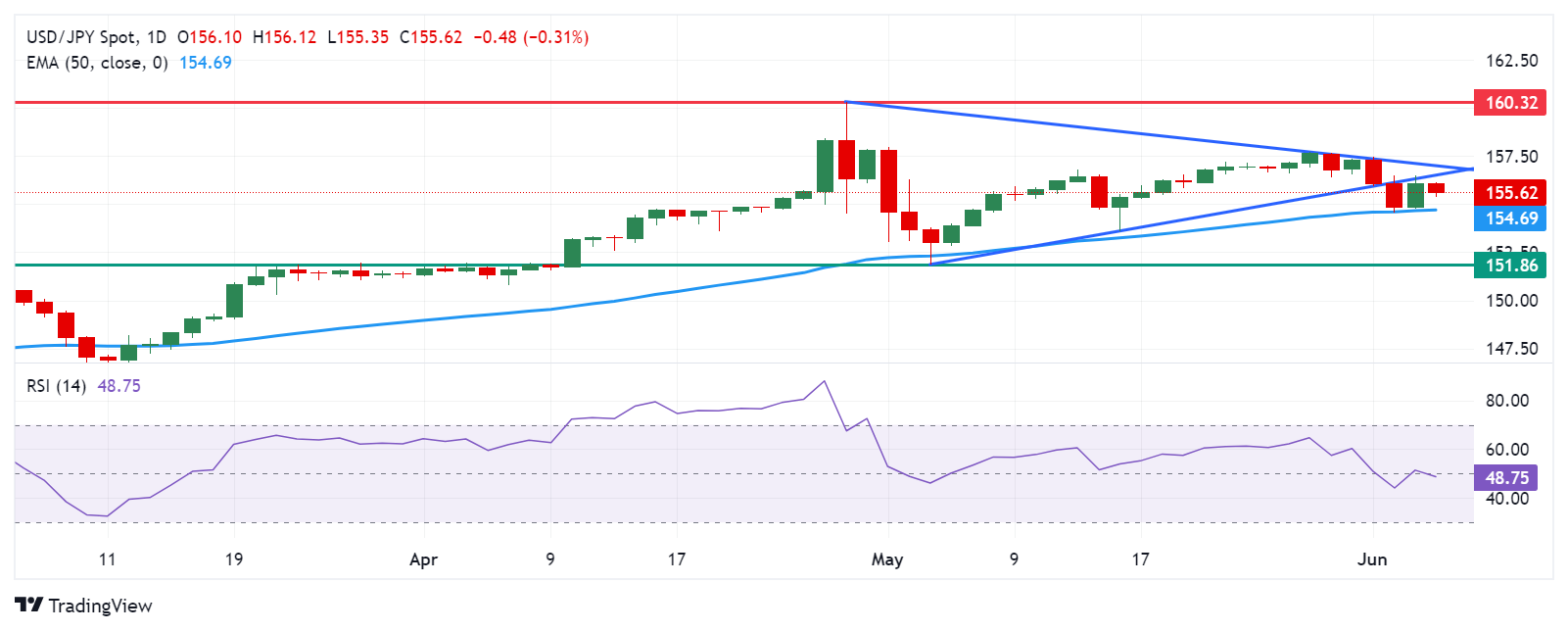- The Japanese Yen edges lower as investors turn toward the USD ahead of the US NFP due on Friday.
- Japan’s 10-year bond yield fell below 1% for the first time in two weeks.
- The US Dollar may struggle as mixed economic data fuel speculation of rate cuts by the Fed.
The Japanese Yen (JPY) retraced its gains on Thursday, while the US Dollar (USD) recovered its daily losses due to higher US Treasury yields. However, the rising speculation of an interest rate cut by the US Federal Reserve (Fed) in September could limit the upside of the Greenback and USD/JPY pair. Investors are likely awaiting key US employment data releases on Friday, including Average Hourly Earnings and Nonfarm Payrolls.
Japanese bond yields have pulled back from recent highs, with the benchmark 10-year government bond yield falling below 1% for the first time in two weeks. However, Japan’s real wages declined for the 25th straight month in April as domestic inflation continued to outpace wage growth. This data will make it more challenging for the Bank of Japan (BoJ) to normalize its policy.
The US Dollar Index (DXY), measuring the value of the US Dollar (USD) against six other major currencies, faced challenges following the release of mixed economic data in the United States (US). This has heightened investors's sentiment surrounding the Fed rate cuts. According to the CME FedWatch Tool, the probability of a Fed rate cut in September by at least 25 basis points has surged to nearly 70.0%, up from 47.5% a week earlier.
Daily Digest Market Movers: Japanese Yen declines ahead of US labor data
- According to Reuters, while speaking to parliament on Thursday, Bank of Japan (BoJ) Governor Kazuo Ueda stated that inflation expectations are gradually rising but have yet to reach 2%. Ueda said, "We are still scrutinizing market developments since the March decision. As we proceed in exiting our massive monetary stimulus, it's appropriate to reduce bond purchases." Additionally, the Bank of Japan (BoJ) board member Toyoaki Nakamura remarked that, according to current data, it is suitable to maintain the policy intact for the time being. Nakamura highlighted that households' purchasing power is weak, emphasizing the necessity of a solid increase in disposable income to encourage spending.
- The ISM US Services PMI on Wednesday soared to 53.8 in May, marking its highest level in nine months and significantly surpassing the forecast of 50.8. In contrast, the ADP US Employment Change report showed that 152,000 new workers were added to payrolls in May, the lowest in four months and well below the forecast of 175,000 and the downwardly revised figure of 188,000 for April.
- The Jibun Bank Japan Services PMI was revised higher to 53.8 in May from the previous figure of 53.6. Despite the upward revision, it fell short of April's 8-month peak of 54.3, indicating the softest growth in the service sector since February.
- Labor Cash Earnings surged by 2.1% year-on-year in April, surpassing forecasts for a 1.7% gain. This latest figure also marked the highest level since June last year.
- The JOLTS US Job Openings declined by 296,000 to 8.059 million in April, down from March's 8.355 million, marking the lowest level since February 2021. This figure also missed the market consensus of 8.340 million, data showed on Tuesday.
- Japan's government will highlight the challenges a weak Yen poses for households in this year's long-term economic policy roadmap. This focus on the Yen's impact is expected to maintain pressure on the Bank of Japan to either raise interest rates or reduce its extensive bond-buying program.
- Last week, Atlanta Fed President Raphael Bostic stated in an interview with Fox Business that he does not think additional rate increases are necessary to achieve the Fed's 2% annual inflation target. Furthermore, New York Fed President John Williams stated as per Reuters that inflation is currently too high but should start to decline in the second half of 2024. Williams believes that monetary policy action is not urgently needed.
Technical Analysis: USD/JPY hovers below 156.00
USD/JPY traded around 155.60 on Thursday. Analysis of the daily chart suggests a weakening bullish bias as the pair breaks below the lower boundary of the symmetrical triangle pattern. Additionally, the 14-day Relative Strength Index (RSI) is slightly below the 50 level, indicating a potential for further decline that may confirm a bearish bias.
Immediate support for the USD/JPY pair could be found at the psychological level of 156.00. Further support appears at the 50-day Exponential Moving Average (EMA) at 154.69. A break below this level could increase pressure on the pair, potentially leading it toward the throwback support region around 151.86.
On the upside, a key barrier is evident at the lower threshold of the symmetrical triangle. If the USD/JPY pair returns to the symmetrical triangle, it would reinforce the bullish bias and could lead the pair to test the upper boundary of the pattern. A break above the psychological barrier of 157.00 would support the pair in retesting 160.32, its highest level in over thirty years.
USD/JPY: Daily Chart

Japanese Yen price today
The table below shows the percentage change of the Japanese Yen (JPY) against listed major currencies today. Japanese Yen was the weakest against the Swiss Franc.
| USD | EUR | GBP | CAD | AUD | JPY | NZD | CHF | |
| USD | -0.02% | 0.05% | 0.02% | 0.08% | 0.12% | 0.16% | -0.05% | |
| EUR | 0.02% | 0.08% | 0.05% | 0.10% | 0.16% | 0.18% | -0.03% | |
| GBP | -0.05% | -0.06% | -0.05% | 0.02% | 0.06% | 0.11% | -0.11% | |
| CAD | -0.02% | -0.05% | 0.05% | 0.05% | 0.10% | 0.15% | -0.07% | |
| AUD | -0.08% | -0.10% | -0.02% | -0.07% | 0.03% | 0.07% | -0.14% | |
| JPY | -0.13% | -0.14% | -0.08% | -0.13% | -0.04% | 0.01% | -0.19% | |
| NZD | -0.15% | -0.18% | -0.11% | -0.15% | -0.09% | -0.04% | -0.21% | |
| CHF | 0.07% | 0.05% | 0.12% | 0.08% | 0.15% | 0.19% | 0.23% |
The heat map shows percentage changes of major currencies against each other. The base currency is picked from the left column, while the quote currency is picked from the top row. For example, if you pick the Euro from the left column and move along the horizontal line to the Japanese Yen, the percentage change displayed in the box will represent EUR (base)/JPY (quote).













